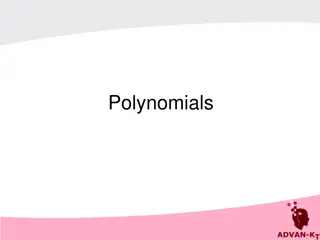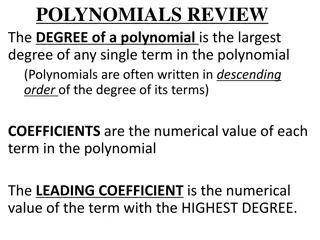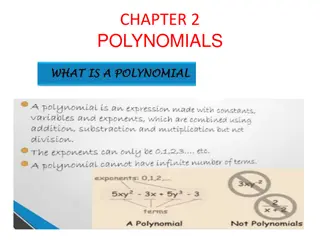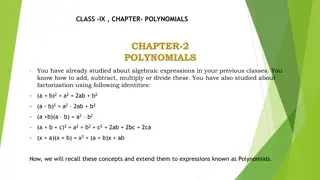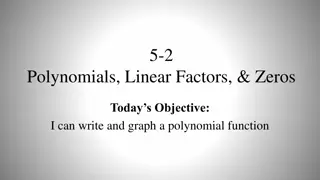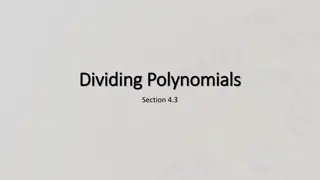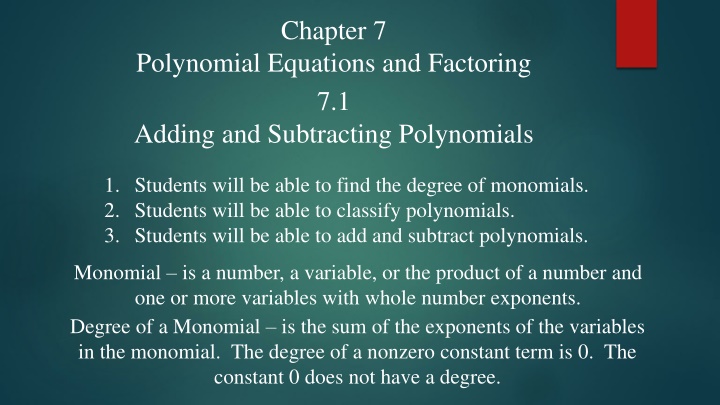
Polynomial Equations and Factoring: Understanding Monomials, Polynomials, and Standard Form
Learn about the fundamental concepts of monomials, polynomials, and standard form in polynomial equations. Understand how to find the degree of monomials, classify polynomials, and write polynomials in standard form while identifying their degree and leading coefficients.
Download Presentation

Please find below an Image/Link to download the presentation.
The content on the website is provided AS IS for your information and personal use only. It may not be sold, licensed, or shared on other websites without obtaining consent from the author. If you encounter any issues during the download, it is possible that the publisher has removed the file from their server.
You are allowed to download the files provided on this website for personal or commercial use, subject to the condition that they are used lawfully. All files are the property of their respective owners.
The content on the website is provided AS IS for your information and personal use only. It may not be sold, licensed, or shared on other websites without obtaining consent from the author.
E N D
Presentation Transcript
Chapter 7 Polynomial Equations and Factoring 7.1 Adding and Subtracting Polynomials 1. Students will be able to find the degree of monomials. 2. Students will be able to classify polynomials. 3. Students will be able to add and subtract polynomials. Monomial is a number, a variable, or the product of a number and one or more variables with whole number exponents. Degree of a Monomial is the sum of the exponents of the variables in the monomial. The degree of a nonzero constant term is 0. The constant 0 does not have a degree.
Degree of a Monomial is the sum of the exponents of the variables in the monomial. The degree of a nonzero constant term is 0. The constant 0 does not have a degree. Monomial Degree Not a monomial 5+x Reason 10 0 A sum is not a monomial A monomial cannot have a variable in the denominator. A monomial cannot have a variable exponent. The variable must have a whole number exponent. 2 a 3x 1 1 2ab 2 4a x 1 2 + = 3 1 5 1.8m 5 Find the degree of each monomial. 1 2xy 2 5x 2 3 3 3 3 8x y 4=1+3 0 6=3+3
Polynomial is a monomial or a sum of monomials. Each monomial is called a term of the polynomial. A polynomial with two terms is a Binomial. A polynomial with three terms is Trinomial. Binomial Trinomial + + 2 x+ 5 2 x x 5 2 Degree of a Polynomial is the greatest degree of its terms. Standard Form is when the exponents of the terms of a polynomial decrease from left to right. Leading Coefficient is the coefficient of the first term when you write a polynomial in standard form.
Standard Form is when the exponents of the terms of a polynomial decrease from left to right. Leading Coefficient is the coefficient of the first term when you write a polynomial in standard form. Degree of a Polynomial is the greatest degree of its terms. Constant Term Leading coefficient Degree + + 3 2 2 5 12 x x x
Write the polynomial in Standard Form, identify the degree, leading coefficient and classify/name the polynomial. 4 9z 9 z + 3 15 3 x x + 4 + + 3 15 3 x x Degree = 3 Degree = 1 Leading Coefficient = -1 Leading Coefficient = -9 Name = Trinomial Name = Binomial
Write the polynomial in Standard Form, identify the degree, leading coefficient and classify/name the polynomial. 4 + + 3z 3z 5 4 5x + 5 x 8q q q 8 2 x 4 4 5 + q 2 x Degree = 4 Degree = 2 Degree = 5 Leading Coefficient = 1 LC= -3 Leading Coefficient = 5 Name = Monomial Name = Binomial Name = Trinomial
Adding and Subtracting Polynomials Combine like terms Like terms have the same variable and the same exponent To Combine just add or subtract the coefficients + ) (2 + + 3 2 2 3 (2 5 1) x x x x x Vertical Format + 3 2 2 5 x x x + + 3 2 2 1 x x + 3 2 3 3 1 x x x
+ ) (2 + + 3 2 2 3 (2 5 1) x x x x x Horizontal Format 3 (2 x + ) ( + + 2 2 3 5 2 1 ) x x x x + ) ( 5 + + ) ( ) + + 3 3 2 2 (2 2 ( 1 ) x x x x x + 3 2 3 3 1 x x x
+ 6) ( + + + 2 2 (3 4 10) x x x x Vertical Format Horizontal Format 2 (3 x + 6) ( + + + 2 4 1 ) 0 x x x + + 2 3 x 6 10 x x x + ) ( + + + + 2 2 (3 4 ) x ( 6 1 0 ) x x x + + 2 4 + + + + 2 2 4 5 4 4 5 4 x x x x
+ 5) ( 2 + 2 2 (4 2 4) x x x Vertical Format + 2 + + 2 4 5 4) x x 4 2 5 4 x x ( 2 + 2 + 2 2 x 2 x + 2 6 2 9 x x
+ 5) (3 2 2 (4 3 8) x x x x Horizontal Format 2 (4 x + 5) (3 2 3 8) x x x + + + 2 2 4 3 5 3 8 x x x x + + ) (5 + + 2 2 (4 3 ) ( 3 8 ) x x x x + 2 2 13 x x
You Trys + + + 3) ( 4 + + + 2 2 ( 3) x x x + x 2 2 3 4 3 x x x x + 2 5 2 x 2) (7 + x 2 2 ( ) x x x x 2 7x + 2 x 2 2 x x x x 2 8 2
Last One YEH!! But First Let us review what we learned today 1. Students will be able to find the degree of monomials. 2. Students will be able to classify polynomials. 3. Students will be able to add and subtract polynomials. + 5) (3 2 And NOW ( 6) x x x+ + 2 5 3 6 x + 2 3 11 x x Good Job!




